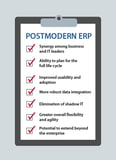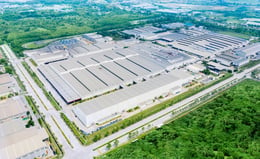How Production Scheduling Increases Customer Satisfaction
Nick Ostdick - July 13, 2017

 Let’s think about the idea of bifocals moment. Essentially, bifocals combine two different focal lengths or intensities into one cohesive line or path of vision. Whether you have difficulty seeing great distances or difficulty seeing images up close, bifocals allow you to experience an enhanced visibility by bringing two seemingly disparate functions into one harmonious operation.
Let’s think about the idea of bifocals moment. Essentially, bifocals combine two different focal lengths or intensities into one cohesive line or path of vision. Whether you have difficulty seeing great distances or difficulty seeing images up close, bifocals allow you to experience an enhanced visibility by bringing two seemingly disparate functions into one harmonious operation.
Now, what do bifocals have to do with production scheduling? Well, just like how bifocals combine two distinct modes of vision, production scheduling combines two distinct elements of the manufacturing cycle into one optimized function: sales forecasting and production planning. By combining these two elements of the production process, companies can not only increase their internal visibility, but they also have the ability increase productivity, accuracy, and agility, each of which is a core driver in enhancing customer service and client relations.
Because production scheduling brings together so many aspects of the production process under one umbrella (everything from the procurement of raw materials to job allocation to monitoring the movement and transport of finished product to ensure on-time delivery), the traditional silo structure often found in global supply chain logistics is broken down and manufacturing companies can better integrate all parts of the manufacturing cycle to better equip themselves to address disruptions or breakdowns in variant-rich industries.
Just like how bifocals improve overall vision, production scheduling improves overall manufacturing efficacy and efficiency. But in order to truly understand the value proposition of production scheduling, let’s examine a handful of ways how production scheduling increases customer satisfaction and how manufacturing companies can work to realize the benefits of integrating a production scheduling solution.
Real-time customer orders and allocation
One of the most important aspects of production scheduling is the ability to, in real-time, process and schedule customer orders relative to existing rules and constraints. No longer are manufacturing companies beholden to scheduling or allocating customer orders without visibility into existing production conditions. Rather, manufacturing companies can utilize enhanced visibility into their overall supply situation to optimize inventory management, facility capacity, and production line efficiency to schedule the right order at the production hub at the right time. In addition, production scheduling gives planners and managers to capacity to alter or modify production programs based on changes in rules and constraints to identify bottlenecks and avoid the implications thereof.
Inventory management driving ordering processes
In the spirit of unifying and integrating disparate production processes, production scheduling originates from a standpoint of having inventory management and optimization drive how manufacturing intake customer orders and prioritize those orders relative to job allocation and production line capacity. The availability of raw materials, safety stock considerations, and the levels of finished products and component parts are taken into account to determine manufacturing quantities and batch sizes. In addition, customer orders can be identified with specific delivery attributes such as time, date, and priority. These attributes allow manufacturing companies to optimize known production parameters such as cost, quantity, and condition for more efficient production programs.
Production simulations based existing customer orders
Because of the real-time visibility and feedback nature of production scheduling, planners and managers can engage in detailed simulations and what-if scenarios based on actual, existing customer orders to more effectively anticipate, plan for, and address potential breakdowns or disruptions in production cycles and workflows. These real-life simulations and what-if planning give manufacturing companies more concrete knowledge, insight, and visibility into their current supply situations to better plan for the short, mid, and long-term future. The value in these detailed simulations has ripple effects across each touch point of the value chain by optimizing each step throughout the manufacturing cycle and creating opportunities for enhanced collaboration and communication.
Production scheduling = increased customer satisfaction?
If we take production scheduling as an umbrella solution that integrates a variety of manufacturing cycle processes into a holistic function where each step works in tandem with the next, then it makes sense that at the end of the day the final result in producing a better product more efficiently that arrives at the customer’s door with greater ease and accuracy. In variant-rich industries, particularly those in competitive sectors, customer satisfaction and customer relations is increasingly becoming a core driver in how companies grow, but also in how they refine their internal processes and logistics.
Just like how bifocals give you an increased sense of sight by combining two disparate elements into one unified action, production scheduling combines sales and production planning into an action where the whole is greater than the sum of its parts.
LATEST POSTS
- Understand Circular Economy in The Manufacturing Industry
- How Can Industry 4.0 IT Integration Be Achieved Smoothly?
- The Significance of Order Sequencing in Discrete Manufacturing
- How to improve your Supply Chain Management: The Power of Control Towers
- Optimizing Human Resource Scheduling in Manufacturing: A Technological Approach



